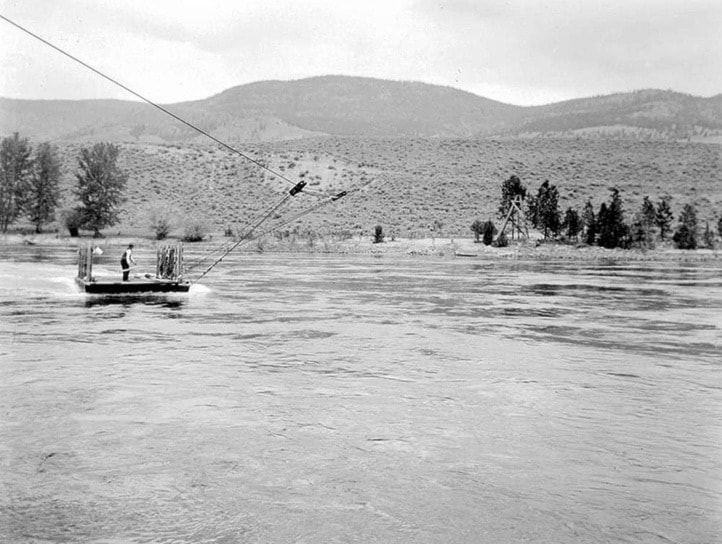Part four of a series looking at the history of Walhachin
The completion, in 1910, of the 12-mile-long flume system that brought water from Deadman’s Creek to the northern side of the Walhachin site made the area even more attractive to would-be settlers. In February 1911, construction began on a bridge across the Thompson River near the former site of the Pennie Ranch. The townsite was on the south side of the river, with the CP line running right through it, so it was easy enough for people to travel to Ashcroft or Kamloops for supplies.
However, 4,000 of the 5,000 acres of orchard land—as well as the flume and the irrigation ditches—were on the north side of the river, and they all needed constant work and maintenance. The only way across the river was via a ferry, which could not operate when the water was too high. The construction of a bridge was therefore a necessity; but to the frustration of residents, work on it was delayed for much of the summer of 1911 because of exceedingly high river levels. It was finally completed in the spring of 1912, and almost 105 years later that same bridge is still serving the community of Walhachin.

Irrigation ditches on the north side of the Thompson River at Walhachin. Photo courtesy Ashcroft Museum and Archives.
Things were looking rosy in the summer of 1912. A barber had arrived from England and set up shop; The Journal reported that he found business was booming. The Walhachin Restaurant was open for business, advertising meals for thirty-five cents each (twenty-five cents if one purchased a booklet containing 21 meal tickets). There was a general store, three laundries, a butcher shop, a bakery and tea room, a dairy, a livery stable, a shop selling ladies’ clothing and notions, two insurance offices, a wood and coal yard, and a post office.
Less than two years after first advertising for settlers, Walhachin boasted 180 permanent residents, of whom 107 were English orchardists and their families. There were also CPR personnel and their families, construction workers, people hired to work at various businesses and operations at the site, a few domestic servants, and Chinese workers who helped in the fields.
Houses were going up all over the site, each one with running water and carbide lighting. By the time the 1912 growing season started, six steam tractors had been purchased to clear the land for orchardists. Walhachin seemed to be living up to the rosy promises made by the British Columbia Development Association, which had funded the establishment of the town; but in a somewhat surprising move the BCDA announced, in June 1912, that it would be removing its financial support from the project and making no further investments in Walhachin. Shareholders were advised to sell their shares and try to recover as much of their investment as they could.
Before anyone could panic, however, a saviour was found in the form of Lieutenant-Colonel Charles Henry Alexander Paget, the 6th Marquess of Anglesey. He had succeeded to the title in 1905, upon the death of his childless cousin the 5th Marquess, and served as mayor of Burton upon Trent in East Staffordshire, England from 1911 to 1912. Quite how Walhachin in far-off British Columbia came to his attention is not known, but before long Anglesey had bought up all the Walhachin holdings of the BCDA, assumed financial control of other companies developed there, and purchased the Walhachin Hotel.
In the summer of 1912 he came to Walhachin and began construction of his own estate—Anglesey—on the north bank of the river, three miles west of the town. Construction of the house was finished in spring 1913, and Anglesey then moved on to the construction of a cement-lined swimming-pool near the house, which none but the most exclusive residents of Walhachin could use.
Fortunately, however, the Marquess was not as snobbish as this move would seem to imply. The Walhachin Hotel had, until he purchased it, allowed only “upper class” clientele to make use of the dining and beverage rooms; but the new owner soon made it clear that the hotel would serve any client, no matter what their class, who wanted to use it. Whether this demonstrated a healthy lack of class-consciousness, or was merely a canny business move, remains unknown; but fellow settlers found him to be a friendly, unassuming, and hard-working man who was more than prepared to toil alongside his men out in the fields.
By the end of 1912 a cannery and packing plant had been added to the townsite, and a community centre, ice rink, and polo field were still to come. Walhachin was doing well; supplementary crops, such as potatoes, tomatoes, and onions, were keeping the community ticking over until the tens of thousands of apple trees that had been planted began to bear fruit. Afternoon tea was served daily in the hotel, and card parties, musical evenings, and concerts were regular occurrences.
Balls were held frequently, with dance classes ensuring that the calibre of dancing did not become unfashionably rural, and it was not uncommon for guests from as far afield as Kamloops and Vancouver to attend, staying overnight and returning home by train. Despite the Marquess of Anglesey’s relaxing of the rules at the hotel, those who went there for dinner or for entertainments were encouraged to wear full evening dress, as if they were in the West End of London rather than the far west of Canada.
The card parties, which were played for high stakes, caused something of a controversy, attracting as they did female players as well as male. Such mixed-gender gambling affairs were common in the English society from which many of the Walhachin settlers came, but they raised eyebrows in Savona and Ashcroft, where they came in for criticism. The residents of Walhachin did not seem to care about the opinion of their provincial neighbours, however, and the card parties carried on.
To be continued
